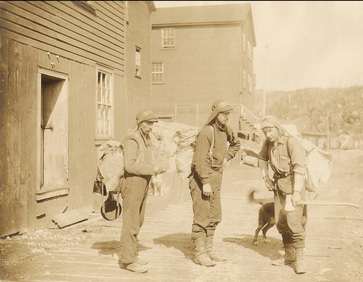In the mid 1800’s the Hudson’s Bay Company had taken up the charge of carrying mail along their wide-ranging network of trading routes between posts. The Michipicoten Post near Wawa was a trans-shipment centre for mail between 1840 and 1858. In that year the Canadian Postal Service contracted the steamer RESCUE from Collingwood to carry mail on Lake Superior which included Sault Ste. Marie, Batchawana and Michipicoten. The steamer MANITOBA took over the route from 1875 to the mid-1880’s.
During the winter months mail was handled by dog sled. The “Hudson’s Bay Trail” from Sault Ste. Marie to Michipicoten followed a well worn path to Batchawana, skirted the shore at Mamainse Harbour, travelled overland to Agawa, then headed north in virtually a straight line to the mouth of the Michipicoten River. The Agawa Post was 2 days travel by dog team from Sault Ste. Marie and another 2 days to Michipicoten. From here the route then split with one heading northwest 80 kilometres to the logging operations on the Pukaskwa River, and the other cut northeast across Wawa Lake to follow the 60 kilometre “Grasset Trail” to the Canadian Pacific Railway.
And who were these mail carriers? Jack Legarde was a resident of Michipicoten Harbour at the turn of the 19th century, but he was more often likely to be found on the trails between the Harbour, Pukaskwa and Franz. It was said that Jack could drive anything with hair and his dog team was always an interesting collection of breeds. His days and nights were often spent with his dogs, no matter what time of year and no matter how close to civilization and a warm bed his work day ended.
Bill Ennor was a Scottish immigrant who found work in Michipicoten between 1906 and 1912 as a miner, logger and mail carrier. Bill beat the fates twice while sledding through our Northern Ontario blizzards. The first experience was during a 3 day mail route which would have ended in disaster if not for the rescue efforts of a Michipicoten Ojibway named Kimmieshaw.
The second incident occurred near the Algoma Central Railway junction to one of Wawa’s iron mining operations. Due to a blinding snowstorm, Bill was unable to gauge his sleds distance from the rail line. A train suddenly appeared, struck his sled and killed his lead dog. Bill managed to bury his dog and reharness the remaining team, but could not locate his packages. He carried on in the direction of the train only to meet it again. This time it was blowing its whistle and a crewman was hanging out the side swinging a lamp. Apparently the train crew was completely unaware of the collision until they got to their destination and discovered Bill’s mailbags tangled in the cow catcher at the front of the engine. The bags were intact, returned to Bill and the mail was delivered to their rightful owners.
As you speed along the Trans-Canada Highway connecting the remote communities of Superior’s east shore, you are no doubt travelling some of the same rugged routes covered by the early mail carriers and their noisy dog teams freighting supplies, catalogues and messages from home to the early settlers and residents of Northern Algoma.

 RSS Feed
RSS Feed
